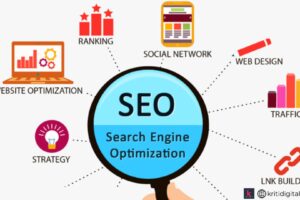If you’re running an ecommerce business in 2025, chances are you’re constantly pulled between long-term strategies and immediate growth. The biggest tug-of-war? Choosing between SEO and paid advertising. It’s the ultimate digital marketing dilemma — should you invest in building organic traffic through content and search engine optimization, or should you pour money into paid ad campaigns for faster results?
This debate isn’t just popular; it’s crucial. Knowing which approach will serve your goals can drastically impact your traffic, conversions, and profitability. In this article, we’ll break down the pros and cons of both strategies, explore how to integrate them, and help you decide what’s best for your ecommerce store. By the end, you’ll have a clear understanding of what SEO vs. Paid Ads truly means in today’s competitive digital landscape — and how to use both intelligently.
Let’s unpack this digital marketing face-off.
Understanding the Two Pillars of Ecommerce Visibility
To appreciate the power of both SEO and paid ads, you first need to understand what they are. SEO, or search engine optimization, involves optimizing your ecommerce site to rank higher in search engine results organically. This includes keyword research, on-page content strategy, technical fixes, link-building, and user experience improvements. It’s a strategy built for long-term success, targeting users actively searching for your products or content.
Paid advertising, on the other hand, includes platforms like Google Ads, Facebook Ads, Instagram, and even TikTok. It enables brands to appear directly in front of their audience via sponsored placements. The moment your ad goes live, you can start seeing clicks and sales — but it comes at a cost and often stops the moment you stop spending.
So, what’s more valuable — the trust and long-term stability of SEO or the instant gratification of paid campaigns?
1. Time to Results: Patience vs. Speed
This is the most obvious difference. SEO is a slow burn. You won’t see massive results overnight, and building domain authority takes months of consistent work. But the traffic you gain through SEO tends to be stable, recurring, and cost-effective over time.
Paid ads are fast. Want traffic today? Launch a campaign and you could see results within hours. This makes paid ads ideal for product launches, flash sales, and new customer acquisition goals — especially when time-sensitive results are critical.
However, once the ad budget is paused, so is the traffic. That’s where SEO proves more sustainable.
2. Budget Allocation: Fixed Spend vs. Strategic Investment
When comparing SEO vs. Paid Ads from a cost perspective, it’s not about which is cheaper — it’s about ROI. SEO typically requires upfront investment in content, audits, and possibly an SEO specialist or agency. But once optimized, your website keeps attracting traffic with little incremental cost per visitor.
Paid ads demand a continuous budget. It’s a pay-to-play model, and costs can escalate quickly, especially in competitive niches like fashion, beauty, or tech. The benefit is predictability — you know what you’re spending and the exact return. The downside? Your customer acquisition cost (CAC) could keep rising if you’re not constantly refining your targeting and creative.
3. Audience Targeting: Intent vs. Interest
SEO targets users with intent. When someone types “buy wireless headphones online,” they’re ready to purchase. Ranking for such high-intent keywords means you’re catching prospects at the decision-making stage.
Paid ads can target users based on demographics, behavior, and interests. Someone scrolling Instagram may not be actively shopping, but a visually appealing ad can generate interest and drive them into your funnel. This makes paid ads powerful for brand awareness and top-of-funnel campaigns — even if the intent isn’t always transactional.
4. Long-Term Value: Compounding Growth vs. Constant Reinvestment
A well-executed SEO strategy compounds over time. Your blog posts, category pages, and product descriptions become digital assets. As your domain authority grows, ranking for more competitive keywords becomes easier. This passive traffic source keeps working for you, even when your marketing budget tightens.
Paid advertising doesn’t have a compounding effect. It’s more like a faucet — turn it on and the traffic flows, but turn it off and everything stops. That’s not necessarily bad if you have the budget and margins to sustain it, but it does create pressure to keep reinvesting to maintain performance.
5. Trust and Credibility: Organic vs. Sponsored
Studies show that users trust organic search results more than ads. Appearing on the first page of Google organically lends credibility to your brand. For ecommerce businesses trying to build trust and long-term loyalty, this matters. SEO helps you show up as an authority in your niche — through helpful blog content, customer reviews, and optimized pages.
Paid ads, while visually prominent, carry a “sponsored” label. For newer or lesser-known brands, this can be a hurdle. People may click but not convert because they don’t yet trust you. That’s why paid campaigns often work best when paired with trust signals like reviews, social proof, or strong landing pages.
6. Data Insights and Testing Capabilities
Paid ads excel when it comes to rapid A/B testing. Want to know which offer, creative, or call-to-action performs better? You can find out in real-time, then scale what works. Platforms like Meta and Google Ads give you granular control over performance metrics, allowing you to refine campaigns weekly or even daily.
SEO insights come slower. Tools like Google Search Console, Ahrefs, or SEMrush provide valuable keyword and ranking data, but results take time to materialize. You’ll need patience to understand what’s working — and it may require deeper analysis to connect SEO efforts to revenue.
7. Integration: Why the Best Strategy Combines Both
Here’s the truth: it’s not about choosing between SEO and paid ads — it’s about finding the right mix. Many of the top ecommerce brands in the world don’t rely on just one. Instead, they use SEO to build a stable foundation and paid ads to accelerate growth and dominate high-competition terms.
Use SEO to create educational blog content, optimize product descriptions, and build long-tail traffic. Then, use paid ads to retarget users who visited but didn’t buy, push time-limited promotions, or test new product lines.
For example, if your SEO strategy ranks you for “eco-friendly yoga mats,” you could run Google Shopping ads for product variants to capture additional shelf space on the results page. The result? Higher visibility, more clicks, and stronger brand dominance.
Who Should Focus on SEO?
If you’re building a brand for the long term, care about content marketing, or want to reduce your cost-per-acquisition over time, SEO is the way to go. It’s especially valuable for niche ecommerce stores where keyword competition isn’t overwhelming. SEO also pairs well with content-heavy industries like health, fashion, home decor, or tech accessories.
It’s also a must for anyone enrolled in an Advanced Digital Marketing Course, where understanding the synergy of organic growth and technical performance is critical to mastering digital strategy.
Who Should Use Paid Ads?
If you need results now — like promoting a new product, running a seasonal sale, or hitting revenue goals quickly — paid ads will get you there faster. Startups, D2C brands, and dropshippers often lean heavily on paid strategies to test markets and scale rapidly.
Just remember, your margin must support it. And you’ll need continuous ad creative refreshes, funnel testing, and targeting tweaks to maintain performance.
Final Thoughts: SEO vs. Paid Ads – It’s Not Either/Or
Ecommerce marketing is not a zero-sum game. The most successful brands don’t choose between SEO and paid ads — they combine them. SEO provides a solid foundation and long-term growth. Paid ads provide scalability and speed. When integrated thoughtfully, the two create a full-funnel marketing strategy that drives both acquisition and retention.
Don’t fall into the trap of chasing short-term wins or investing only in the distant future. Map your strategy to your current growth stage, budget, and goals. Then continuously evaluate performance to keep evolving.
As algorithms change and competition rises, the brands that win will be the ones who master both disciplines, balancing patience with agility and content with conversion.



